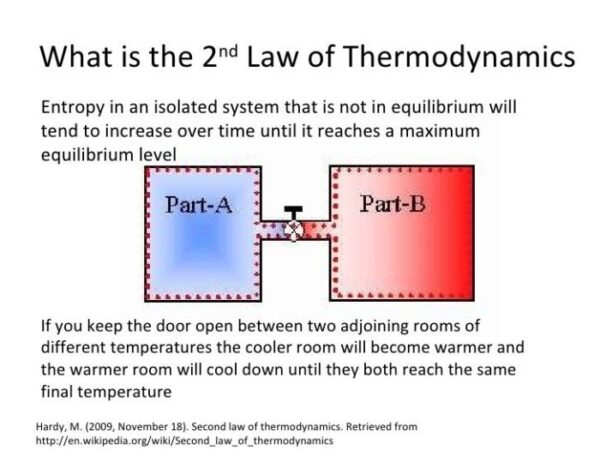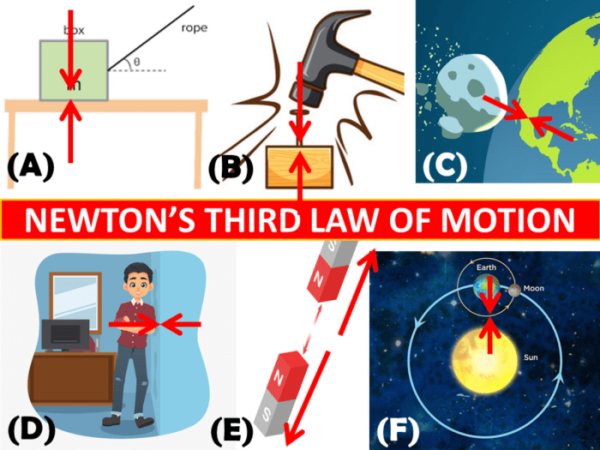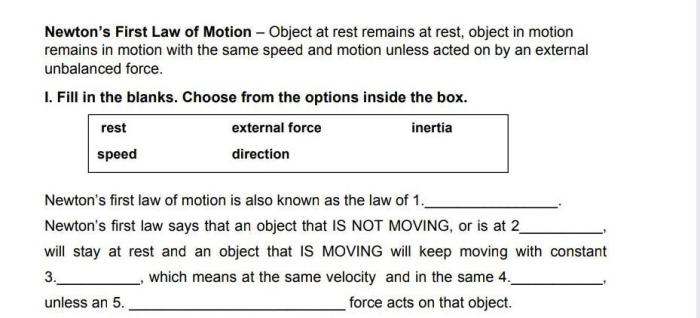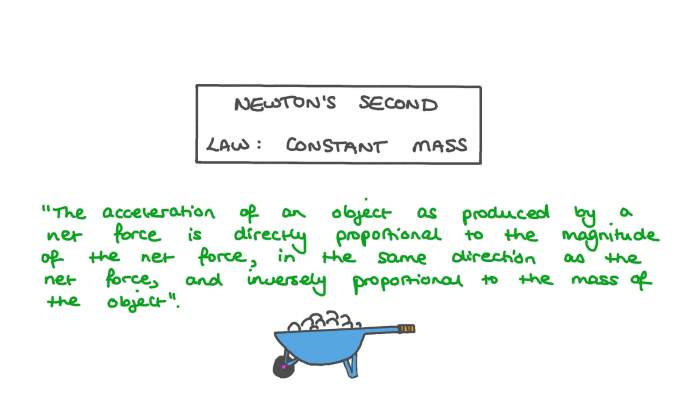
- Introduction to Newton’s Third Law
- Statement of the Law
- Examples of Newton’s Third Law
- Applications of Newton’s Third Law: What Is Newton’s Third Law Of Motion
- Misconceptions about Newton’s Third Law
- The Role of Mass in Newton’s Third Law
- Newton’s Third Law and Other Laws of Motion
- Last Point
- Essential Questionnaire
What is Newton’s Third Law of Motion sets the stage for an exploration into the fundamental principles governing forces and interactions in the universe. Imagine pushing against a wall – you feel the wall pushing back with equal force. This seemingly simple observation embodies the essence of Newton’s Third Law. This law, discovered by the renowned physicist Sir Isaac Newton, explains the intricate interplay of forces that govern everything from walking to rocket propulsion. It reveals the hidden dance of action and reaction, a dance that shapes our world.
At its core, Newton’s Third Law states that for every action, there is an equal and opposite reaction. This means that when one object exerts a force on another, the second object exerts an equal and opposite force back on the first. This principle applies to all interactions, whether it’s the impact of a ball bouncing off a wall or the delicate balance of a bird in flight. By delving into the intricacies of this law, we can unravel the mysteries of motion and gain a deeper understanding of the forces that govern our universe.
Introduction to Newton’s Third Law
Newton’s Third Law of Motion is a fundamental principle in physics that describes the interaction between objects. It states that for every action, there is an equal and opposite reaction. This law governs how forces are applied and experienced in the physical world.
The significance of Newton’s Third Law lies in its ability to explain a wide range of phenomena, from the propulsion of rockets to the simple act of walking. It helps us understand how forces are generated and how they affect the motion of objects.
Historical Context
Newton’s Third Law was first proposed by Sir Isaac Newton in his seminal work, *Philosophiæ Naturalis Principia Mathematica*, published in 1687. This work laid the foundation for classical mechanics, a branch of physics that studies the motion of objects under the influence of forces. Newton’s Third Law was one of the three laws of motion that he formulated, which revolutionized our understanding of the universe.
Newton’s discovery was a culmination of the work of many scientists who came before him. The concept of action and reaction was explored by philosophers and scientists like Aristotle and Galileo, who studied the motion of objects and the forces that act upon them. Newton’s contribution was to formalize this concept and express it mathematically, making it a cornerstone of classical mechanics.
Statement of the Law
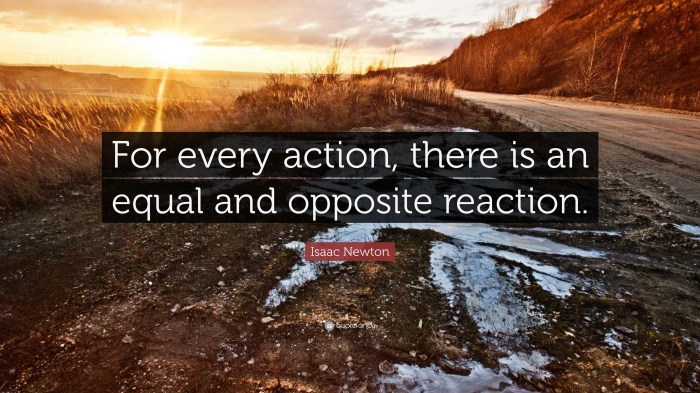
Newton’s Third Law of Motion, also known as the law of action and reaction, is a fundamental principle that governs the interactions between objects. It states that for every action, there is an equal and opposite reaction.
This law implies that forces always occur in pairs, with each force acting on a different object. The “action” force is exerted by one object on another, while the “reaction” force is exerted by the second object back on the first. These forces are always equal in magnitude and opposite in direction.
Defining Action and Reaction
The terms “action” and “reaction” in Newton’s Third Law are simply labels for the two forces that make up an interaction. The “action” force is the force that is applied first, while the “reaction” force is the force that is applied in response. For instance, if you push against a wall, the wall pushes back on you with an equal and opposite force. In this case, your push against the wall is the “action” force, and the wall pushing back on you is the “reaction” force.
Equal and Opposite Forces
The concept of equal and opposite forces is crucial to understanding Newton’s Third Law. This means that the two forces in an interaction have the same magnitude (strength) but act in opposite directions. For example, if you jump off a diving board, your feet exert a downward force on the board, and the board exerts an upward force on your feet. These forces are equal in magnitude and opposite in direction, allowing you to propel yourself upward.
Examples of Newton’s Third Law

Newton’s Third Law of Motion, often paraphrased as “for every action, there is an equal and opposite reaction,” governs the interaction of forces between objects. This principle applies to all interactions in the universe, from the mundane to the extraordinary. To better understand this law, let’s explore some real-world examples.
Examples of Newton’s Third Law in Action, What is newton’s third law of motion
These examples demonstrate how forces act in pairs, always equal in magnitude and opposite in direction.
| Scenario | Action Force | Reaction Force | Result |
|---|---|---|---|
| Walking | Your foot pushes backward on the ground. | The ground pushes forward on your foot. | You move forward. |
| Swimming | Your arms and legs push backward on the water. | The water pushes forward on your arms and legs. | You move forward through the water. |
| Rocket Launch | The rocket expels hot gases downward. | The gases push upward on the rocket. | The rocket accelerates upward. |
| Jumping | Your legs push downward on the ground. | The ground pushes upward on your legs. | You launch yourself upward. |
Applications of Newton’s Third Law: What Is Newton’s Third Law Of Motion
Newton’s Third Law, with its emphasis on equal and opposite forces, has profound implications in various fields. It governs how objects interact and move, impacting our understanding of everyday phenomena and complex technological advancements.
Rocket Propulsion
Rocket propulsion exemplifies Newton’s Third Law in action. Rockets generate thrust by expelling hot gases from their engines. The hot gases, moving in one direction, exert a force on the rocket in the opposite direction, propelling it forward.
The force exerted by the rocket on the gases is equal and opposite to the force exerted by the gases on the rocket.
This principle is crucial for space travel, allowing rockets to overcome Earth’s gravity and reach the vast expanse of space.
Walking
Walking is a seemingly simple act, yet it relies heavily on Newton’s Third Law. When we walk, we push our feet against the ground. In response, the ground exerts an equal and opposite force on our feet, propelling us forward.
The force exerted by our foot on the ground is equal and opposite to the force exerted by the ground on our foot.
This interaction between our feet and the ground allows us to move forward, showcasing the fundamental role of Newton’s Third Law in everyday activities.
Swimming
Swimming, like walking, involves the application of Newton’s Third Law. Swimmers propel themselves through water by pushing against it with their limbs. The water, in turn, exerts an equal and opposite force on the swimmer, propelling them forward.
The force exerted by the swimmer on the water is equal and opposite to the force exerted by the water on the swimmer.
This interaction between the swimmer and the water allows them to navigate through the water, highlighting the versatility of Newton’s Third Law in various mediums.
Collision Dynamics
Newton’s Third Law plays a pivotal role in understanding collisions between objects. When two objects collide, they exert equal and opposite forces on each other. These forces, acting over a short period, cause changes in momentum and energy, determining the outcome of the collision.
The force exerted by object A on object B is equal and opposite to the force exerted by object B on object A.
This principle governs the transfer of momentum and energy during collisions, influencing factors such as rebound velocity, deformation, and the generation of heat.
Misconceptions about Newton’s Third Law
Newton’s Third Law is a fundamental principle in physics, but like many scientific concepts, it can be subject to misunderstandings. These misconceptions often arise from an incomplete understanding of the law’s implications and the subtle interplay of forces involved.
Equal and Opposite Forces Act on the Same Object
One common misconception is that the equal and opposite forces described by Newton’s Third Law act on the same object. This is incorrect. The law states that for every action, there is an equal and opposite reaction, but these forces act on different objects.
“For every action, there is an equal and opposite reaction.” – Isaac Newton
For example, consider a book resting on a table. The book exerts a downward force on the table due to gravity. The table, in turn, exerts an upward force on the book, preventing it from falling through. These forces are equal in magnitude and opposite in direction, but they act on different objects: the book and the table.
The Forces Cancel Each Other Out
Another misconception is that the equal and opposite forces described by Newton’s Third Law cancel each other out. While it is true that the net force on a system of two interacting objects is zero, the forces themselves do not disappear.
Consider a rocket launching into space. The rocket expels hot gas downwards, which exerts a force on the rocket. The rocket, in turn, exerts an equal and opposite force on the gas. These forces do not cancel each other out; they act on different objects (the rocket and the gas). The rocket accelerates upwards due to the force exerted by the gas, while the gas accelerates downwards due to the force exerted by the rocket.
Newton’s Third Law Explains Motion
Newton’s Third Law does not explain motion. It describes the interaction between objects, but it does not explain how objects move. To understand motion, we need to consider all the forces acting on an object and apply Newton’s Second Law of Motion, which states that the acceleration of an object is directly proportional to the net force acting on it and inversely proportional to its mass.
For example, consider a car accelerating forward. The car’s engine exerts a force on the car, causing it to accelerate. The car’s tires also exert a force on the road, and the road exerts an equal and opposite force on the car’s tires. These forces are equal and opposite, but they do not cancel each other out because they act on different objects. The car accelerates forward because the force exerted by the engine is greater than the force exerted by the road.
The Role of Mass in Newton’s Third Law
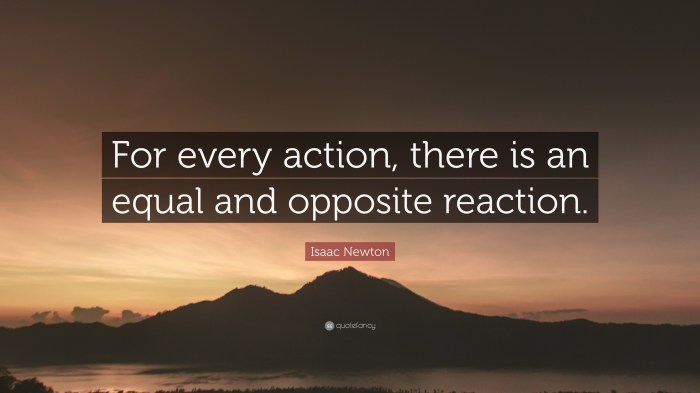
Newton’s Third Law, often stated as “for every action, there is an equal and opposite reaction,” implies that forces always occur in pairs. While this principle holds true regardless of the masses involved, the impact of these forces on the motion of objects is significantly influenced by their masses.
The Relationship Between Mass and Force
Mass is a fundamental property of matter that measures its resistance to changes in motion. The greater the mass of an object, the more force is required to accelerate it. In the context of Newton’s Third Law, this means that while the forces acting on two interacting objects are always equal and opposite, the resulting accelerations will be inversely proportional to their masses.
For example, imagine a small car and a large truck colliding. The car and the truck exert equal and opposite forces on each other during the collision. However, due to the truck’s significantly larger mass, the car will experience a much greater acceleration, resulting in more severe damage.
Momentum and Newton’s Third Law
Momentum is a measure of an object’s mass in motion and is calculated by multiplying the object’s mass by its velocity. The principle of conservation of momentum states that the total momentum of a closed system remains constant. This principle is directly related to Newton’s Third Law.
In a closed system, when two objects interact, the momentum gained by one object is equal to the momentum lost by the other object. This ensures that the total momentum of the system remains constant.
Examples of Mass Impacting Force and Motion
The influence of mass on the forces and motion involved in Newton’s Third Law can be observed in various everyday scenarios:
- Rocket Propulsion: Rockets work by expelling hot gas out of their nozzles. The expelled gas exerts a backward force on the rocket, while the rocket exerts an equal and opposite force on the gas. The rocket’s acceleration is determined by the mass of the expelled gas and the force it exerts. A larger mass of gas expelled with greater force will result in a faster acceleration.
- Jumping: When you jump, your feet push down on the ground, and the ground pushes back with an equal and opposite force. This upward force propels you into the air. The greater your mass, the greater the force required to overcome gravity and jump higher.
- Collision of Objects: As mentioned earlier, when two objects collide, they exert equal and opposite forces on each other. The resulting acceleration of each object is inversely proportional to its mass. A heavier object will experience a smaller acceleration than a lighter object.
Newton’s Third Law and Other Laws of Motion
Newton’s Third Law of Motion, which states that for every action, there is an equal and opposite reaction, is just one part of a larger framework for understanding motion and forces. To truly grasp its implications, it’s crucial to consider how it interacts with Newton’s First and Second Laws of Motion.
Relationship Between Newton’s Laws of Motion
Newton’s three laws of motion work together to provide a complete description of how objects move under the influence of forces. Understanding their interrelationships is essential for comprehending the principles of mechanics.
- Newton’s First Law (Law of Inertia): An object at rest stays at rest, and an object in motion stays in motion with the same speed and in the same direction unless acted upon by an unbalanced force. This law defines the concept of inertia, the tendency of an object to resist changes in its state of motion.
- Newton’s Second Law (Law of Acceleration): The acceleration of an object is directly proportional to the net force acting on it and inversely proportional to its mass. This law quantifies the relationship between force, mass, and acceleration, providing a mathematical framework for analyzing motion.
- Newton’s Third Law (Law of Action and Reaction): For every action, there is an equal and opposite reaction. This law emphasizes that forces always occur in pairs, with each force acting on a different object.
How the Laws Work Together
Consider the example of a rocket launching into space.
- Newton’s First Law: Before ignition, the rocket is at rest. It remains at rest due to inertia, resisting any change in its state of motion.
- Newton’s Second Law: When the rocket engines ignite, they exert a force on the exhaust gases, causing them to accelerate backward. The rocket experiences an equal and opposite force in the forward direction, propelling it upward. The greater the force of the engines, the greater the rocket’s acceleration.
- Newton’s Third Law: The rocket’s engines push the exhaust gases backward (action), and the exhaust gases push the rocket forward (reaction). These forces are equal in magnitude and opposite in direction.
Importance of Understanding All Three Laws
Comprehending all three of Newton’s laws of motion is essential for:
- Predicting motion: Understanding how forces interact with objects allows us to predict their motion. For example, engineers use these laws to design vehicles, aircraft, and other machines.
- Analyzing physical phenomena: Newton’s laws are fundamental to understanding a wide range of physical phenomena, including gravity, friction, and collisions.
- Developing new technologies: Advancements in fields like robotics, aerospace, and materials science rely heavily on principles derived from Newton’s laws of motion.
Last Point
Newton’s Third Law of Motion is a cornerstone of physics, illuminating the fundamental principles that govern the interactions between objects. It underscores the interconnectedness of forces, revealing how every action has a corresponding reaction. This law, with its elegant simplicity, finds applications in countless areas of science and engineering, from the design of rockets to the understanding of collisions. By embracing the concept of action and reaction, we gain a deeper appreciation for the intricate workings of the universe, recognizing the interconnectedness of all things.
Essential Questionnaire
Does Newton’s Third Law apply to all forces?
Yes, Newton’s Third Law applies to all forces, including gravitational, electromagnetic, and nuclear forces.
Can Newton’s Third Law be used to explain why we can walk?
Yes, when we walk, we push our feet against the ground. The ground, in turn, exerts an equal and opposite force on our feet, propelling us forward.
Why don’t we feel the reaction force when we push a wall?
We do feel the reaction force, but the wall is stationary, so it doesn’t move in response. The force is absorbed by the wall’s structure.
